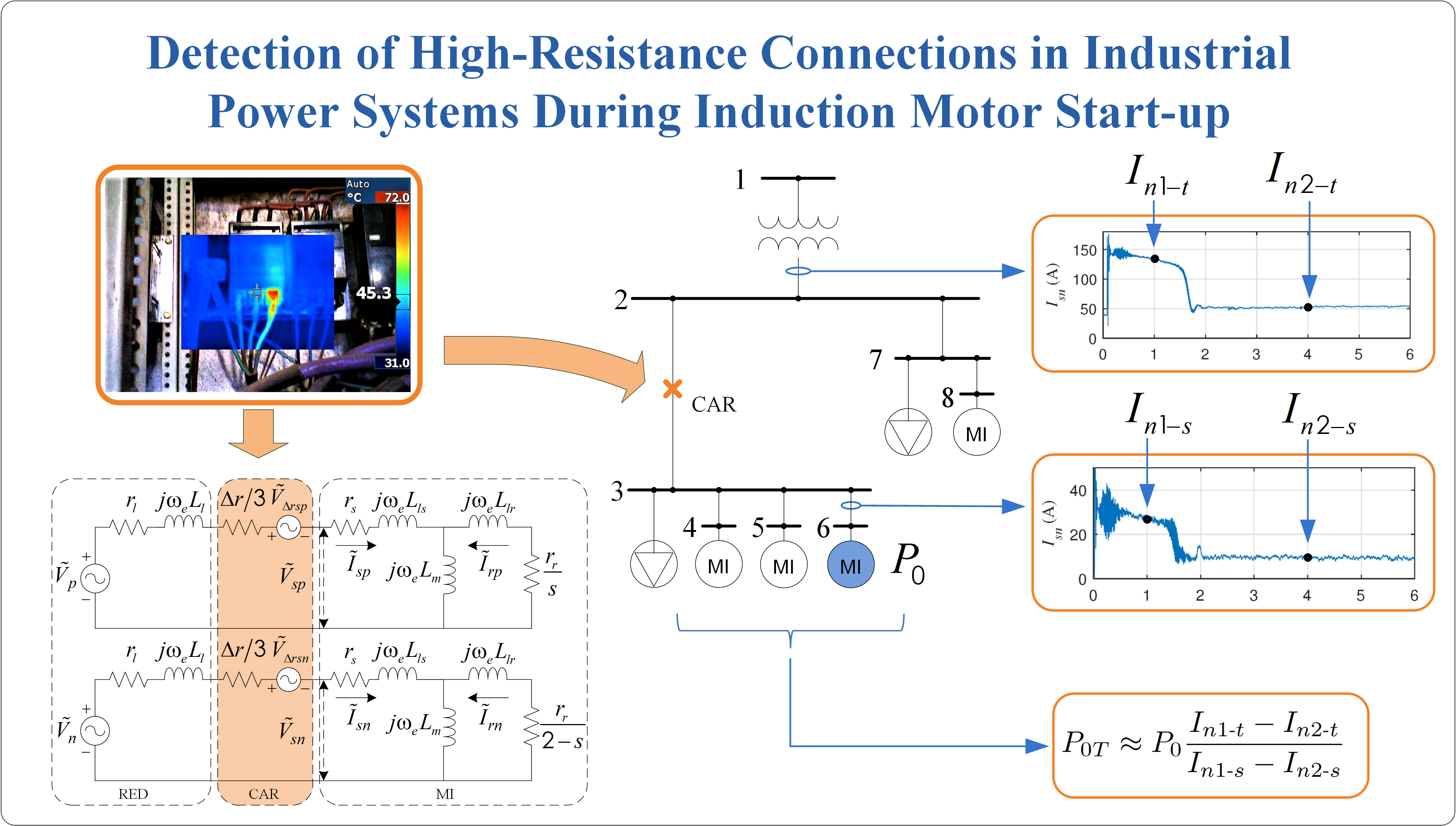Detection of High-Resistance Connections in Industrial Power Systems During Induction Motor Start-up
Keywords:
High–resistance connection, induction motor, fault diagnosis, negative sequence current, start-up transientAbstract
We propose a methodology for detecting and isolating high-resistance connections (HRC) in industrial power systems during induction motor (IM) start-up. Negative sequence components are analyzed during the IM start-up transient in different points of the electric system of an industrial plant. The effects of HRC are evaluated using an analytical model of an industrial power system in steady state and validated with numerical simulations obtained of a transient model. These results show not only the possibility to detect HRC but also its isolation from unbalance voltage conditions of the grid. In addition, an approximation of the total power of motors affected by the HRC is calculated with our proposal. This power and the electric one-line diagram of the industrial plant allow us to determine the location of HRC. Finally, the proposal is validated by using experimental results obtained in a meat processing industry.
Downloads
References
J. Yun, J. Cho, S. B. Lee, and J. Yoo, “Online detection of high-resistance connections in the incoming electrical circuit for induction motors,” IEEE Trans. Ind. Appl., vol. 45, no. 2, pp. 694–702, March 2009.
P. M. de la Barrera, G. R. Bossio, and J. A. Solsona, “High-resistance connection detection in induction motor drives using signal injection,” IEEE Trans. Ind. Electron., vol. 61, no. 7, pp. 3563–3573, July 2014.
V. Babrauskas, “How do electrical wiring faults lead to structure ignitions,” in Proc. Fire and Materials 2001 Conf, 2001, pp. 39–51.
A. T. de Almeida, F. J. T. E. Ferreira, and G. Baoming, “Beyond induction motors: Technology trends to move up efficiency,” IEEE Trans. Ind. Appl., vol. 50, no. 3, pp. 2103–2114, 2014.
Z. Maljkovic, M. Cettolo, and M. Pavlica, “The impact of the induction motor on short-circuit current,” IEEE Ind. Appl. Mag., vol. 7, no. 4, pp. 11–17, July 2001.
“Accelerating the global adoption of energy - efficient electric motors and motor systems,” UN Environment Program Global Environment Facility - United for Efficiency (U4E), Paris, FRANCE, Report U4E POLICY GUIDE SERIES, 2017.
P.Donolo,G.Bossio,C.D.Angelo,G.Garc ́ıa,andM.Donolo,“Voltage unbalance and harmonic distortion effects on induction motor power, torque and vibrations,” Elect. Pow. Syst. Res., vol. 140, pp. 866 – 873, 2016.
P. Donolo, C. Pezzani, G. Bossio, C. De Angelo, and M. Donolo, “Derating of induction motors due to power quality issues considering the motor efficiency class,” IEEE Trans. Ind. Appl., pp. 1–1, 2020.
J. Yun, K. Lee, K. Lee, S. B. Lee, and J. Yoo, “Detection and classi- fication of stator turn faults and high-resistance electrical connections for induction machines,” IEEE Trans. Ind. Appl., vol. 45, no. 2, pp. 666–675, March 2009.
R. S. Colby, “Detection of high-resistance motor connections using symmetrical component analysis and neural network models,” in 4th IEEE Inter. Symp. on Diag. for Elect. Machines, Pow. Electr. and Drives, 2003. SDEMPED 2003., Aug 2003, pp. 2–6.
J.Yoon,J.Yun,S.B.Lee,andE.J.Wiedenbrug,“Automatedmonitoring of high-resistance connections in the electrical distribution system of industrial facilities,” in 2008 IEEE Ind. Appl. Soc. Ann. Meet., Oct 2008, pp. 1–8.
J. Bockstette, E. Stolz, and E. Wiedenbrug, “Upstream impedance diagnostic for three-phase induction motors,” in 2007 IEEE Inter. Symp. on Diag. for Elect. Machines, Pow. Electr. and Drives, Sep. 2007, pp. 411–414.
M. Mengoni, L. Zarri, Y. Gritli, A. Tani, F. Filippetti, and S. B. Lee, “Online detection of high-resistance connections with negative-sequence regulators in three-phase induction motor drives,” IEEE Trans. Ind. Appl., vol. 51, no. 2, pp. 1579–1586, March 2015.
P.M.delaBarrera,G.R.Bossio,andR.Leidhold,“Onlinevoltagesen- sorless high-resistance connection diagnosis in induction motor drives,” IEEE Trans. Ind. Electron., vol. 62, no. 7, pp. 4374–4384, July 2015.
“IEEE recommended practice for conducting motor-starting studies and analysis of industrial and commercial power systems,” IEEE Std 3002.7- 2018, pp. 1–107, April 2019.
N. Matanov, “Study of the impact of induction motors starting on the supply voltage,” in 2019 16th Conf. on Elect. Machines, Drives and Pow. Syst. (ELMA), June 2019, pp. 1–5.
J.C.Go ́mez,C.Reineri,G.Campetelli,andM.M.Morcos,“Astudyof voltage sags generated by induction motor starting,” Elect. Pow. Compo. Sys., vol. 32, no. 6, pp. 645–653, 2004.
J. C. Go ́mez and M. M. Morcos, “Estimation of voltage sag effects on sensitive equipment due to induction motor starting cycles,” Elect. Pow. Compo. Sys., vol. 31, no. 7, pp. 709–716, 2003.
M. Fisher, R. Downey, S. Tomlinson, and J. Babcock, “Determining available fault current based on motor starting characteristics,” in 2011 58th IEEE Petrol. and Chem. Ind. Conf. (PCIC), Sep. 2011, pp. 1–9.
P. Donolo, G. Bossio, and C. D. Angelo, “Analysis of voltage unbalance effects on induction motors with open and closed slots,” Energy Convers. Manag., vol. 52, no. 5, pp. 2024 – 2030, 2011.
P. C. Krause, O. Wasynczuk, S. D. Sudhoff, and S. Pekarek, Analysis of electric machinery and drive systems, 3rd ed. IEEE Press, 2013.
I. Carugati, C. M. Orallo, P. G. Donato, S. Maestri, J. L. Strack, and D. Carrica, “Three-phase harmonic and sequence components measure- ment method based on msdft and variable sampling period technique,” IEEE Trans. Instrum. Meas., vol. 65, no. 8, pp. 1761–1772, Aug 2016.
S. Golestan, J. M. Guerrero, and J. C. Vasquez, “Three-phase plls: A review of recent advances,” IEEE Trans. Power Electron., vol. 32, no. 3, pp. 1894–1907, March 2017.
I. Carugati, S. Maestri, P. G. Donato, D. Carrica, and M. Benedetti, “Variable sampling period filter pll for distorted three-phase systems,” IEEE Trans. Ind. Electron., vol. 27, no. 1, pp. 321–330, Jan 2012.


